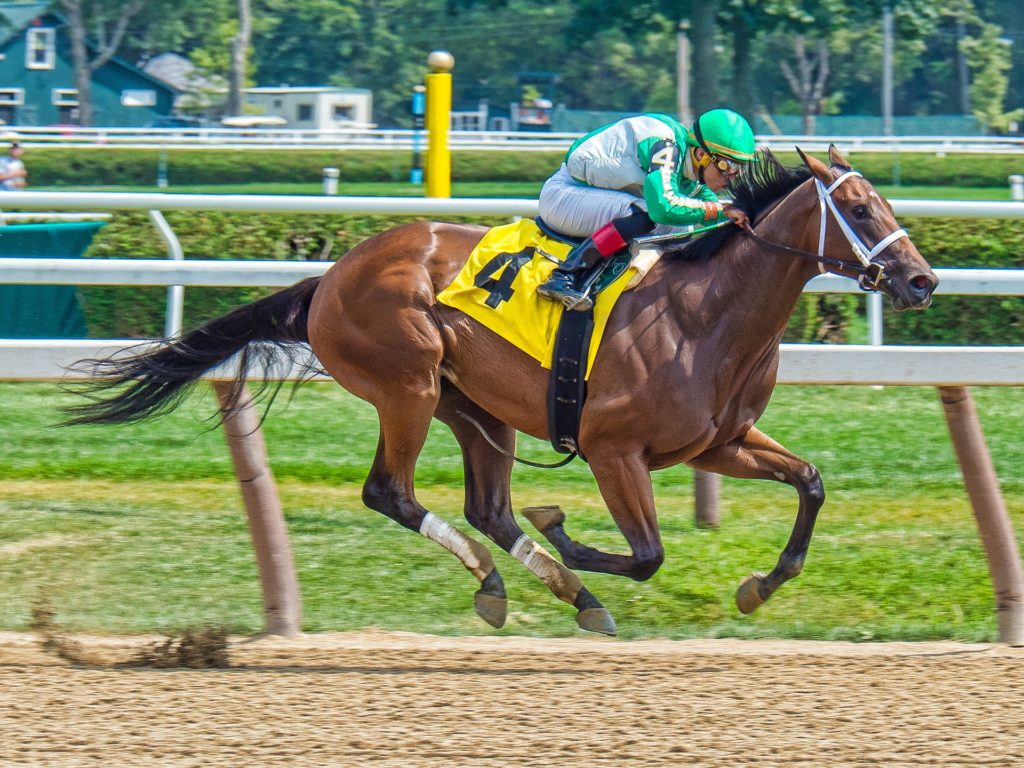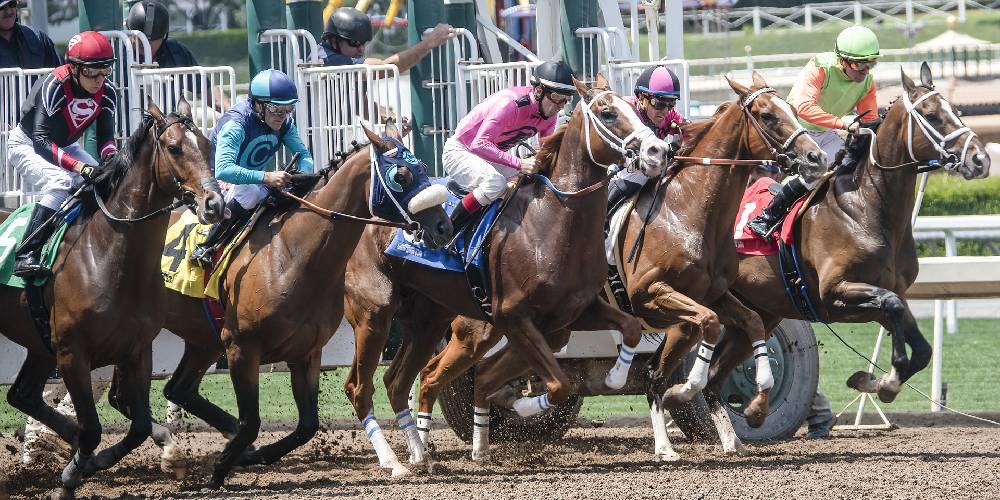The Triple Crown is a series of three races, and to win them all is an extremely difficult and honorable achievement. There are only a few horses in the history of the triple crown that have won it all. What are the three races a horse must win? What horses have won the triple crown? And when did it all start?
What Is The Triple Crown?
The triple crown is a series of three horse races, consisting of the Kentucky Derby, the Preakness Stakes, and the Belmont Stakes. All of these races are run typically by three-year-old Thoroughbred racehorses. If a horse wins all three races, they are named a triple crown winner, but because it is extremely difficult to win all three races, there aren’t many winners.
What Three Races Does The Triple Crown Consist Of?
The Kentucky Derby

The Kentucky Derby is probably the most famous of all the races in the triple crown. In a normal year, the Kentucky Derby attracts around 150,000 fans who pack into the stands to cheer on their favorite horses.
Every year, the Kentucky Derby has a winner who will then go on to race at the Preakness and Belmont Stakes.
The most expensive horse in history was actually a winner of the Kentucky Derby in the year of 2000. The horse, named Fusaichi Pegasus, was sold not long after his Derby victory for 70 million dollars. He even has a 24 karat gold statue made in his honor.
The horses who race in the Kentucky Derby run a total distance of 1.25 miles before crossing the finish line. The race is typically held at Churchill Downs, and the horses who run in this race are usually around three years of age. The Kentucky Derby is held every year on the first Saturday of May.
The Preakness Stakes

The Preakness Stakes is the next race on the agenda to potentially win the Triple Crown. The Preakness Stakes is held at a race track in Maryland called the Pimlico Race Course. Taking place after the Kentucky Derby in mid-May, this race is 1 3/16 miles in distance and is run by the horses who ran in the Kentucky Derby just weeks before.
The race normally takes place on the third Saturday of May and sees a crown of over 100,000 people on average. The average purse for this race is $1,500,000 with the winning horse taking home 60% of the purse. The rest of the purse money is divided up among the rest of the horses depending on what they placed.
The first time this race was held was in the year of 1867. The last filly to win the Preakness Stakes was a three-year-old Thoroughbred named Rachel Alexandra who won the race in 2009. The filly was a hall of fame horse as well making her a crowd favorite.
The Belmont Stakes

The Belmont Stakes is the third and final race to take place in the Triple Crown. The race is held on the second Saturday of June at Belmont Park in New York.
The race officially started to take place in the year 1867 like the Preakness Stakes and is officially the oldest of the three races that makeup the triple crown.
The Belmont Stakes is the longest and hottest race of the three races that the horses compete in. The reason for this is that it is held in June and the race is a total distance of 1.5 miles which is longer than any other race in the Triple Crown.
The fastest time run in the Belmont Stakes was done by none other than the famous Triple Crown winner Secretariat. This stallion clocked an extraordinary time of 2 minutes and 24 seconds over one and a half miles.
The Belmont stakes is held five weeks after the Kentucky Derby and three weeks after the Preakness Stakes.
Winners Of The Triple Crown
Sir Barton
Sir Barton was the very first winner of the Triple Crown. This horse, a chestnut Thoroughbred racehorse, was born in 1916 and won the Triple Crown as a three year old in the year of 1919.
The jockey that rode Sir Barton was named Earl Sande. Sadly, Sir Barton passed away in 1937 due to a colic incident and was buried near his paddock at his Hylton’s Ranch.
Strangely enough, Sir Barton wasn’t recognized as a Triple Crown winner until long after his death in the year 1950.
Gallant Fox
Gallant Fox was a bay Thoroughbred with a small white sock on his right hind leg and a facial marking identified as either a small blaze or wide stripe. Gallant Fox was born in 1927 and passed away in 1954.
Unlike most racehorses, Gallant Fox had a racing career that only spanned from 1929 to 1930. In the year that he spent on the track, he ran a total of seventeen races, winning eleven of them. When he was three he ran ten races winning nine of them.
Gallant Fox had a remarkable breeding career after his days on the track ended. He stood at stud for twenty-two years after his victory in the triple crown. Among his offspring were the 1935 Triple Crown winner Omaha and the 1936 Horse of the Year.
Omaha
Omaha was the third winner if the Triple Crown. This horse was sired from the second winner of the Triple Crown Gallant Fox, and followed in his father’s footsteps and won the Triple Crown on his own.
Omaha, in his racing career, ran twenty two races and won nine times. Born in 1932, his racing career spanned from the time he was two in 1934 to retirement at the age of four in 1934.
Omaha was a chestnut Thoroughbred stallion with one small white sock on one of his hind legs. Like his father, he had a white facial marking that could be classified as a small blaze or a wide stripe.
War Admiral
War Admiral was the fourth winner of the Triple Crown and took home that victory in 1937. Not only did he win the Triple Crown in 1937, he also was named Horse of the Year in the same year.
War Admiral was a bay Thoroughbred who was born in 1934 and died in 1959. He, in 1938, ran a special match race at Pimlico Race Course against Seabiscuit which sadly he lost.
War Admiral was sired from none other than Man o’ War himself. War Admiral sired a number of his own top quality Thoroughbred racehorses, but none met his achievement as Triple Crown winner.
Whirlaway
Whirlaway became the fifth winner of the Triple Crown in the year of 1941. Not only did he earn the achievement of winning the Triple Crown, but he also had the honor to be named American Horse of the Year.
Whirlaway was a Chestnut Thoroughbred Stallion who stood at only 15.3 hands high. In his training he was known for being high-spirited and difficult to handle, though this all paid off when he won the Triple Crown.
Though he was smaller than most of his rivals and harder to handle than most horses, he showed what he was worth through his achievements in the racing world.
Count Fleet
Count fleet, the sixth winner of the Triple Crown, was quite the success in the track. When running in the Belmont Stakes, he beat his opponents by a record of 25 lengths.
In the season where he won the Triple Crown, he remained undefeated and was, like many other Triple Crown winners, titled as Horse of the Year.
Count Fleet was born in 1940, stood at 16 hands high, and had a bay coat color. This horse shocked many horse experts by his success as his confirmation was not that of a typical champion. Count Fleet won the Triple Crown in 1943.
Assault
Assault was a Hall of Fame horse who won the Triple Crown in 1946. Born in 1943, Assault was a Thoroughbred racehorse like all the previous Triple Crown winners, but he had mustang influence in his breeding. It is thought that it was the mustang breeding that make Assault such a successful horse.
Assault was a Texas born horse and was raised by his owners and trainers on a ranch called King’s Ranch. As a weanling, Assault actually had a foot injury caused from stepping on a stake that nearly required him to be put down. Surprisingly, Assault healed and later became a Triple Crown Champion.
Assault stood at chest 15.1 hands high making him really small compared to other Thoroughbred race horses. It is though the the Mustang influence in his blood made him as small as he was, but no one knows for sure. This stallion was chestnut in color like many Triple crown winners.
Due to his foot injury at a young age, Assault limped when walking and trotting. Because of this limp it was thought that he would break down or deteriorate if the injured hoof was used, but surprisingly, he ran smooth and straight and din’t show any signs of pain or injury at the gallop.
Citation
Known for being undefeated in 16 consecutive races, Citation was one of the greatest horses of all time. He reached the mile stone of being the first horse to ever win one million dollars in earnings over the span of his racing career.
Citation was born in 1945, and passed away at the ripe old age of 15 in 1970. Citation was put into the Hall of Fame in 1959, 11 years after his Triple Crown victory.
This horse was a bay like many other Triple Crown horses and had just one little white markings on one of his hind feet. He had no facial markings to be seen.
Secretariat
Secretariat is probably one of the most famous horses in the world. This chestnut stallion was identifiable by his three white socks and exceptional speed.
The secret to Secretariat’s success was actually the immense size of his heart which was two times bigger than a normal horse’s. Secretariat was born in 1970 and won the Triple Crown in 1973.
Sadly, Secretariat passed away in 1989 from laminitis, a severe foot problem with no cure often seen in horses.
Secretariat beat the previous record in lengths between him and the other horses at the Belmont Stakes where he won the race leaving the next closest horse at 31 lengths behind him.
Seattle Slew
Seattle Slew was the tenth Triple Crown champion who took home the victory in 1977. Born in 1974, Seattle Slew was a dark bay stallion who stood at 16 hands high.
Before his death in 2002, Seattle Slew had won his owners over 1.2 million dollars. This horse was undefeated before and after his Triple crown victory. He had won all nine of the races that he had ever competed in making him the first horse to accomplish this.
This amazing stallion is buries on a farm in Kentucky and has a bronze statue of himself near his grave.
Seattle Slew was such a competitive horse that other horses and riders were terrified of him. Jockeys racing horses next to the big bay horse were worried that he would bite at them or hurt them to try to get the advantage and win.
Affirmed
As the eleventh winner of the Triple Crown, Affirmed won all three races to earn this title just one year after Seattle Slew took home the title. Affirmed was a chestnut horse with a connected star and stripe on his face. This horse, during nearly his entire racing career, met ten tomes with a horse named Alydar. The two had a famous rivalry, but Affirmed came out on top.
Affirmed was born in 1975 and passed away in 2001. He led an incredible racing and breeding career and sired a number of successful racehorses.
Affirmed was named Horse of the Year in 1978 as a three year old. His triple crown victory was the first time the Triple crown had been won in consecutive years.
American Pharaoh
American Pharaoh, a gorgeous bay stallion, won the Triple Crown as the first horse to win it in nearly forty years. This magnificent Thoroughbred stallion not only won the triple crown, but he won the breeders cup as well.
American Pharaoh, because he won all four races (Kentucky Derby, Preakness Stakes, Belmont Stakes, and Breeders Cup), officially became the first horse to win all four races known as the Grand Slam in horse racing.
American Pharaoh has sired a number of successful racehorses.
When it comes to markings, American Pharaoh doesn’t have any, making him entirely bay.
Justify
Justify, a Thoroughbred born the year American Pharaoh won it all, took the title of 13th Triple Crown winner home in 2018. Justify is a chestnut stallion with a blaze and fetlock marking. His great successes in the racing industry allowed him to earn nearly 3.8 million dollars.
Justify, now retired, stands at stud and his first offspring are soon going to be able to race in the same races their father won.

